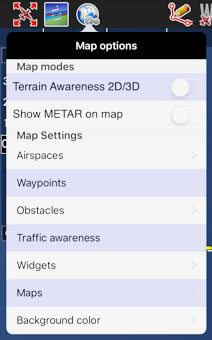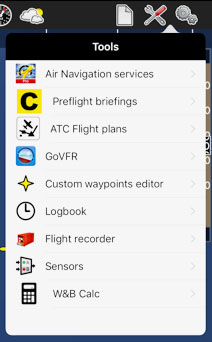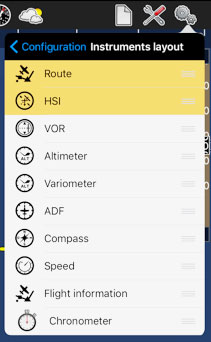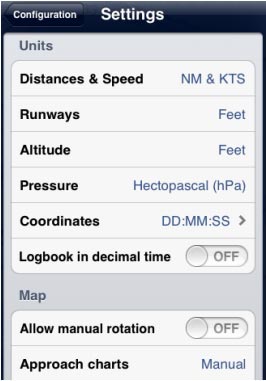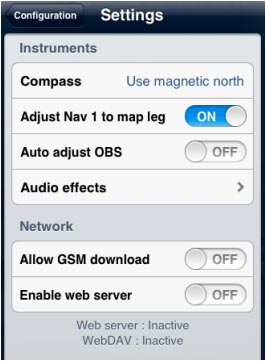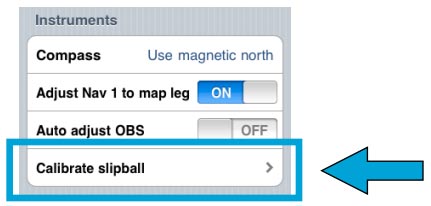Sur l’iPad , ce bouton permet de passer du mode plein écran au mode carte + route + instrument. Sur l’iPhone, ce bouton permet de masquer/afficher la barre d’information en bas de la carte.
Permet d'exécuter le module EFIS. Tout d’abord vous devez télécharger les données 3D dans le « Map Store ». Sur l'iPhone, il est accessible depuis l’onglet en bas à droite de l’écran.
Affiche le panneau des réglages de la carte. Dans les réglages de la carte vous pouvez configurer les éléments qui seront affichés et comment ils seront affichés. Par exemple, il est possible d’activer/masquer certaines cartes. Il est aussi possible de sélectionner les espaces aériens et les points de navigation. Une option permet aussi d’afficher la coupe de terrain en bas de la carte. Les options disponibles dans ce menu sont:
- Allumer/éteindre le mode nuit;
- Montrer/cacher l’arrière-plan de la carte (les cartes installées);
- Montrer/cacher le graphique d’élévation du terrain;
- Activer l’avertissement du terrain 2D/3D;
- Afficher les symboles des conditions météorologiques (VMC, IMC) sur la carte;
- Configurer le filtre des espaces aériens;
- Configurer le filtre des points de navigation;
- Activer/désactiver la ligne de cap étendue et la ligne de cap vers le prochain point;
- Activer/désactiver les cartes individuelles et choisir quelle carte sera affichée en premier plan;
- Choix de la couleur de fond de carte.
Lorsque Air Navigation affiche une zone où aucune carte n’est installée, il est maintenant possible de choisir cette couleur de fond entre blanc, bleu (mer) et un damier gris.
Permet de passer du «mode Vol» (navigation en temps réel) au «mode Edition» (planification du vol). Lorsque le mode «Edition» est actif, il est possible d’ajouter, de supprimer ou de déplacer des points de la route en appuyant sur la carte. Il est aussi possible d’insérer de nouveaux points en appuyant sur la ligne magenta entre deux points et en les déplaçant vers une nouvelle position.
Afche la base de données des waypoints. Il est possible de rechercher un waypoint ou de voir la liste des points proches, triés par distance.
Affiche la liste des routes enregistrées. Permet de sélectionner une route pour l’afficher sur la carte et charger la liste des points dans le module «Route».
Sélectionne le terrain le plus proche et trace un vecteur direct sur la carte.
Eface la sélection courante sur la carte (route ou vecteur direct). Permet de mettre la carte en mode «Vol libre» (sans destination). Permet de démarrer la création d’une nouvelle route. Permet de cacher les cartes d’approche.
Affiche les temps du vol courant. Sur iPhone, ce module est accessible depuis les onglets en bas de l’écran et l’icône est légèrement différente.
Affiche la liste des instruments. Sur iPhone/iPod, la liste d’instruments est disponible dans l’onglet «Configuration» en bas à droite de l’écran.
Displays a list of «weather stations» and latest METAR/TAF information in a decoded format. You can add stations of your choice by entering an identifier in the search field on top and press return. On iPhone/iPod touch, this module is reachable from the «Configuration» tab at the bottom right corner.
Displays a list of «PDF documents» associated to an airfield. Pressing a document will display its content in full-screen mode. You will also use this tool to create an «Aircraft profile». On iPhone/iPod Touch, this module is reachable from the «Configuration» tab at the bottom right corner.
Displays the «Tools» list where you can find additional utilities. On iPhone/iPod Touch, the tools are reachable from the «Configuration» tab at the bottom right corner. The following are the available options on this menu:
- Air Navigation Services. We refer you to «Xample Services» article in this manual;
- Preflight briefings. NOTAM service. Check «Preflight briefing» article.
- GoVFR tool. We refer you to «Third Party Services» article in this manual;
- Custom Waypoint Editor. You will be able to create user waypoints of different types (Airfield, Heliport, IFR, Navaids, etc);
- Logbook. We refer you to «Logbook» article in this manual;
- Recorded Flights. You can reproduce your flights live on this option. We refer you to «Record a Flight» article in this manual;
- Sensors. We refer you to «Sensors» article in this manual.
- W&B Calc. Weight and Balance calculator after entering the required data in the Aircraft profile.
Displays the «Settings» module where you can fine tune the application behavior and customize units and other settings. We can also find the «Map Store» module within this button, from where you can download both free and commercial maps/charts/data.
When using the Waypoints database search engine, you can enable/disable the countries displayed to make the search easier.This button also displays the «Instrument Layout» menu, where the instruments are reordered on top of the list in order to appear in the «split» screen when using an iPad. In this case, only the first two will show together with the moving map. On an iPhone/iPod Touch, the «Instruments Layout» menu will reorder the first 4 instruments to show them in the Bottom bar. All the mentioned modules and settings are reachable from the «Configuration» tab at the bottom right corner on an iPhone/iPod Touch.
The following «Settings» are available:
- Units. Gives the possibility to change the units of the displayed values:
- Distance & speed: NM&KTS, M&Mph, km&km/h; - Runway lengths: meters, feet; - Altitude: meters, feet; - Pressure (AHRS g mini): hPa, inHg; - Coordinates: DD:MM:SS, decimal, DD:MM.mm; - Logbook time: HH:MM, decimal.
If you wish to change Fuel/Length units, you can do this in the Aircraft profile panel.
- Map. Blocks/allows map rotation.
The option «Approach charts» allows us to choose how the geo-referenced approach charts will be open. Note that in order to use this option, you will first need to purchase the “VFR/IFR” approach charts from the Map Store (not all countries available). «TRK/Bearing» option will allow you choose from showing True North or Magnetic North when creating a Route/displaying next waypoint. When «Hidden points selectable» option is ON, the user can still select a waypoint if it's hidden.
- Instruments. You can choose from displaying the True/Magnetic North when using the Compass. When «Adjust Nav 1 to map leg» is ON, the instrument will automatically be configured to the NEXT waypoint on the map.
Remember that as it`s “Nav 1” it will only affect to the FIRST instrument of the list showing under «Instrument Layout» menu.
You can also choose to «Auto Adjust the OBS» when using the ADF, VOR and HSI. This will automatically align the arrow/CDI of the instrument in direction of the configured waypoint. Sound alerts can be activated from «Audio effects».
- Network. This will show, when enabled, the IP addresses to connect the Mac/PC with the «Embedded WebServer» or the «WebDAV server».
You also have the option for enabling «GSM download», when using 3G/4G network to download charts/data.
- Misc. The user can «RAW the METAR/TAF» information, enable the option that will turn the «flight recorder» ON, and have the possibility to «run the app in the background» on the iPad, if having to temporarily use another app or change settings outside Air Navigation Pro. If Air Navigation remains in the background for more than 10 minutes, it will automatically close to save energy.
«Alternate speed/course» option forces Air Nav compute the data in “time deltas” and not continuously. This will help when the GPS signal is weak and breaks of intermittently.
The «Automatic logbook» option will complete the Block-OFF/Block-ON times and the Take-OFF/Landing times automatically. Please refer to the «Logbook» article more details. «Share GPS via Bluetooth» will let PAIR the device with another one of the same nature (for example an iPad with an iPod Touch) and share the GPS signal.
- Disclaimer. Disables the “Disclaimer” message at the start of the app.
- Default. Reverts to factory settings, WITHOUT deleting or modifying existing waypoints, routes, flights or logbook.
This last option might help in case Air Navigation Pro is not working properly.
- Spinball. This option will only appear in the «Settings» section of the iPhone/iPod Touch. There is not such a feature on an iPad.
To calibrate the spinball, you have to position your iPhone/iPod Touch on a flat surface. Note that only when flying aerobatics the spinball is spinning.
Back to index


